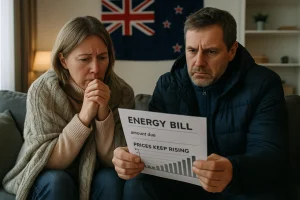Energy Price Inflation
 Electricity prices in New Zealand jumped 15% between April 2024 and April 2025, driven by higher wholesale costs and distribution investments . Gas bills rose nearly 12% over the same period, squeezing household budgets across the country .
Electricity prices in New Zealand jumped 15% between April 2024 and April 2025, driven by higher wholesale costs and distribution investments . Gas bills rose nearly 12% over the same period, squeezing household budgets across the country .
Impact on Mortgage Affordability
The average Kiwi household spends about 5% of its income on energy. This 5% figure is a starting point, but it doesn’t capture the full extent of the issue, especially for vulnerable households who may struggle to afford the basic energy they need to stay healthy. Energy rising to 6%–7% cuts into disposable income and debt-servicing capacity.
Rising energy costs can strain household budgets, especially for mortgage holders in New Zealand. To address this, consider switching to a more competitive electricity plan using Powerswitch, and reducing energy consumption through energy-saving measures. Additionally, explore government support programs such as Moneytalks and consider contacting Utilities Disputes Ltd for assistance with specific issues.
Talk to your financial advisor like us to help with
- Negotiating with your lender: If you are experiencing financial hardship due to rising energy costs, discuss your situation with your bank and explore options like temporary payment holidays or restructuring your mortgage.
- Breaking a fixed rate: While this could save money over time, it will involve a break cost.
- Longer-term strategies: Consider increasing your monthly repayments to reduce your mortgage balance faster and prepare for future rate adjustments.
If you are looking to buy a home. The energy efficiency of a home becomes just as important as the purchase price for keeping costs down.
Healthy Homes Guarantee & Insulation Grants
Healthy Homes Standards in 2025
Under the Residential Tenancies (Healthy Homes Standards) Amendment (No. 2) Act 2023, all rental properties must meet minimum insulation, ventilation, and heating standards by July 2025 . While these rules target landlords, they set buyer expectations for owner-occupied properties too.
Warmer Kiwi Homes & Warmer Healthier Homes
Homeowners can access EECA’s Warmer Kiwi Homes grants. Grants cover 80-90% of insulation costs and up to 80% of heating costs for eligible homeowners.
To be eligible, you must:
- Own and live in a home built before 2008.
- Have ceiling and underfloor insulation installed to EECA standards (or install it first for heating grants).
- Live in a low-income area or hold a Community Services Card.
- Not have certain fixed heaters (heat pump, wood burner, flued gas heater, central heating) in the main living area.
Top Sustainable Upgrades
What can you do to help reduce your energy bills.
- Home Insulation: Insulating walls, ceilings, and floors significantly reduces heat loss and gain, leading to lower heating and cooling bills.
- Rooftop Solar: Installing solar panels allows homeowners to generate their own electricity, reducing reliance on the grid and lowering electricity bills.
- Energy-Efficient Appliances: Replacing older appliances with energy-efficient models can significantly reduce energy consumption.
- Heat Pumps: Upgrading to a heat pump for heating and cooling is a more energy-efficient option than traditional systems like electric heaters.
- Smart Home Automation: Using smart thermostats, lighting controls, and other smart devices can help optimize energy use and reduce waste.
- Green Loans and Rebates: Take advantage of green loans and rebates offered by financial institutions and government programs to help finance sustainable upgrades.
Additional Tips for Energy Efficiency:
- Switch to LED Lighting: LEDs consume significantly less energy than traditional incandescent bulbs.
- Seal Air Leaks: Properly sealing windows, doors, and other potential air leaks can improve energy efficiency.
- Optimise Heating and Cooling: Set thermostats at reasonable levels and use programmable thermostats to save energy.
- Consider Ventilation: Ensure proper ventilation to avoid moisture buildup and ensure comfortable indoor air quality.
- Harvest Rainwater: Install a rainwater harvesting system to reduce reliance on municipal water and potentially use rainwater for irrigation or other non-potable uses.
